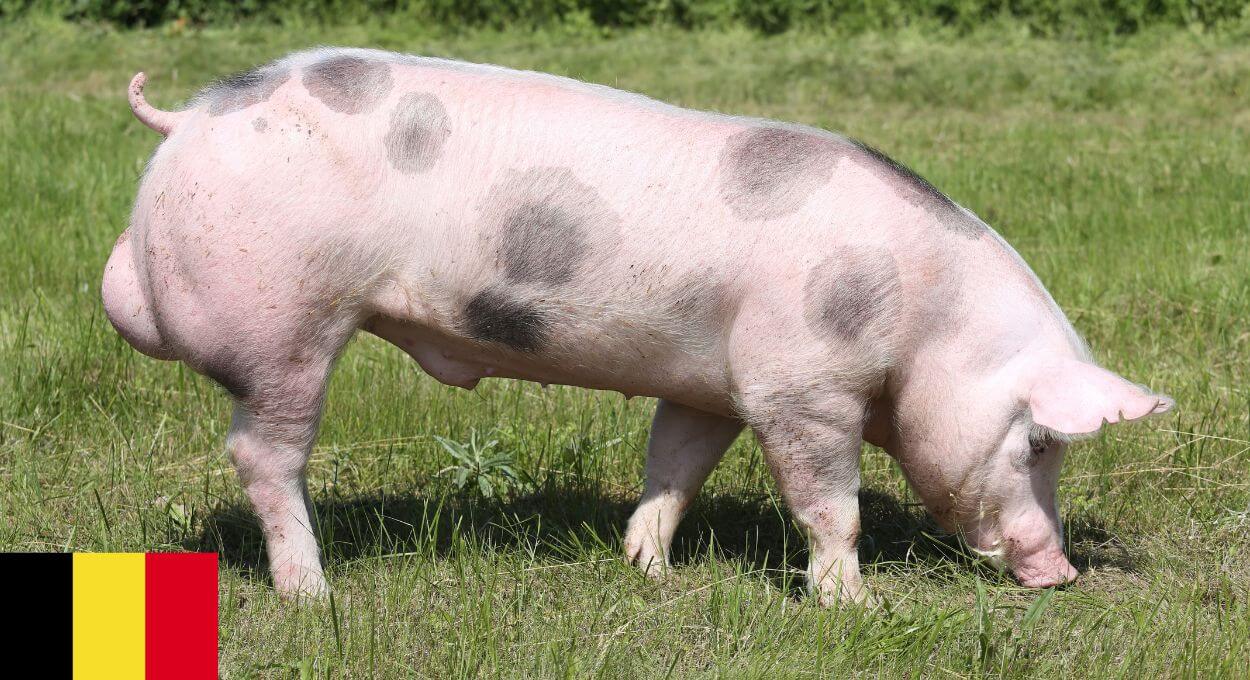
Piétrain is a domestic pig that originates from the town of Piétrain, Belgium near the city of Charleroi. This pig, named after its birthplace, has unknown origins.
According to some stories, Belgian farmers wanted to develop a unique pig breed with a high quantity of lean meat and great carcass traits. While the precise origins and the specific swine breeds involved in creating Piétrain are unknown, it is believed that the farmers selected two local swine breeds known for their double muscling gene.
Over many years, farmers selectively bred the Piétrain pig to improve its desirable traits. The breed was officially recognized as a distinct pig breed in 1950.
Contents
What is a Piétrain pig?
Due to its individual genetics, the Piétrain pig is more than just a domestic pig. As mentioned in its history, farmers aimed to obtain a muscular pig with lots of lean meat. Through their efforts, the Piétrain pig resulted and inherited the halothane gene associated with Porcine Stress Syndrome (PSS).
The presence of the halothane gene in Piétrain pigs results in increased muscle development, as this particular gene causes hypertrophy in the body. This genetic characteristic contributes to this pig breed’s high amounts of lean meat.
Therefore, the Piétrain is a domestic pig with distinct genetics.
Pig Characteristics
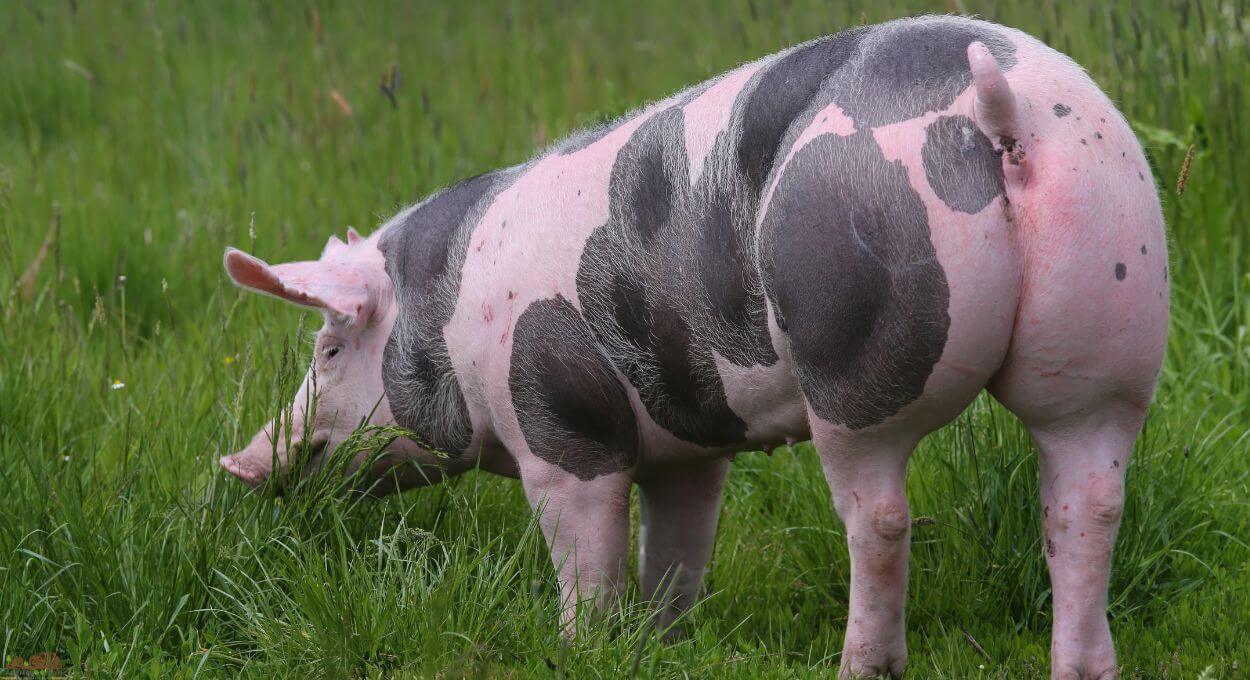
Physical Characteristics
The Piétrain pig’s characteristics are the following:
Color
The color of Piétrain is typically greyish-white with black spots. Some pigs have solid black or solid white coloration. These black spots can be all over the body and have specific rings of lighter pigmentation with white hair. These distinct markings contribute to its reputation as the pig with piebald markings.
Hair
The hair of this pig is short and thick. It is white in the areas without black spots and darker, but not black, in the regions with black spots.
Size
The size of Piétrain pigs is medium. Females typically have an average height of 2.7 feet at the shoulder, while males reach approximately 3 feet. The average length of these pigs ranges from 5 to 6 feet.
Head, Nose, Cheeks, Neck
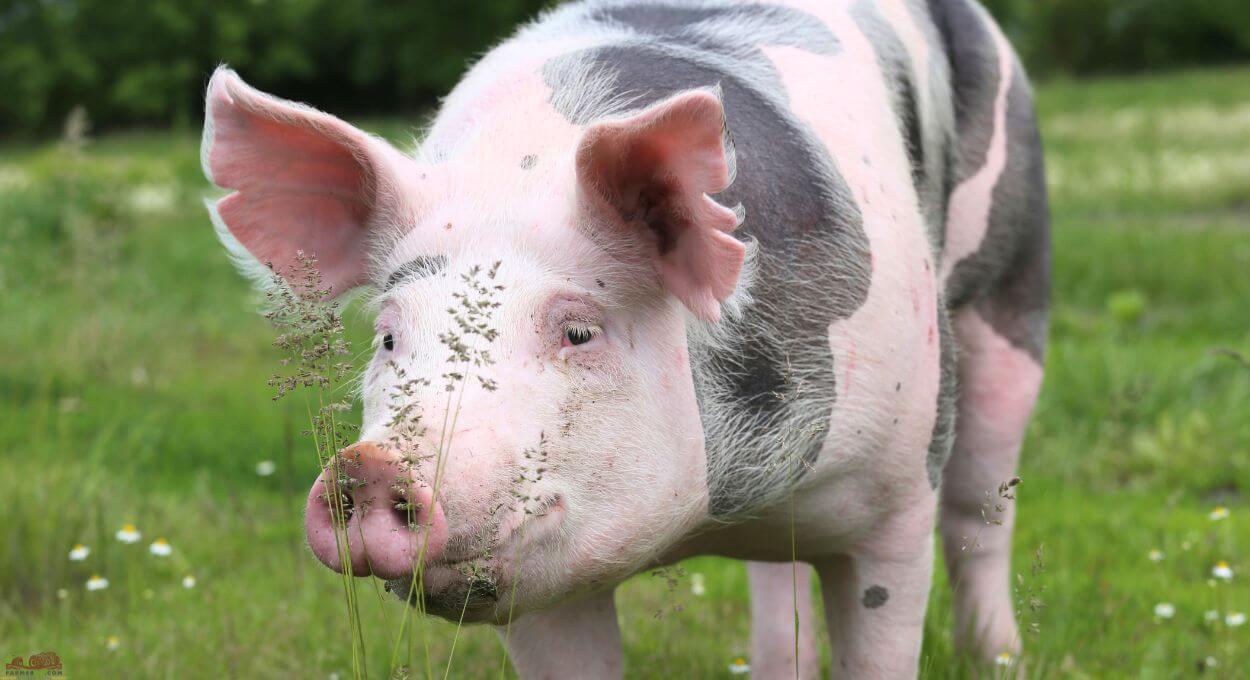
The head can be characterized as lightweight, with a straight profile and a broad forehead, while the nose is also broad and straight. The cheeks are not very prominent, and the neck is relatively short and slender.
Ears
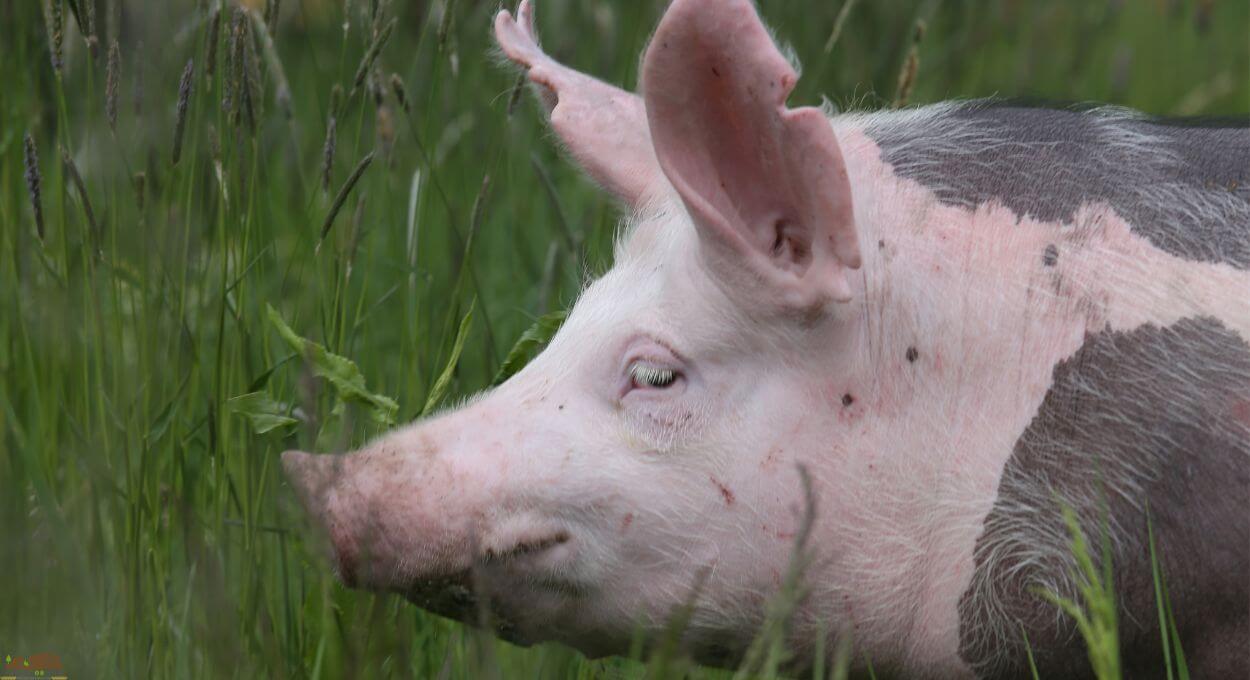
The ears are short and quite broad but medium-sized for its overall head. They are erect, and the tips are slightly bent towards the front, but not too much to cover the vision.
Back, Trunk, Chest, and Belly
The body of the Piétrain pig has a cylindrical shape. Its trunk is massive, muscular, and sturdy, featuring a broad, deep chest. The back of the pig is long, straight, broad, and flat, and its belly is very well tucked in.
Shoulders
The shoulders are very well developed and muscular, which really stands out.
Legs
The legs of this pig are straight, long, and highly muscular, especially around the ham area. The hams are broad, and well-rounded, and begin to descend close to the knuckle joints.
Teats
A Piétrain pig has a total of 12 teats.
Teeth
The Piétrain pig typically has 44 teeth. This includes 12 incisors, 4 canine teeth, 16 premolars, and 12 molars.
Lifespan
You can expect Piétrain pigs to live between 10 to 15 years. These pigs generally have a relatively long lifespan.
Growth Rate
The growth rate of Piétrain pigs is fast, making them one of the fastest-growing pig breeds. They can reach a weight of 220 lbs within 128 days of life.
During their early growth stage, Piétrain pigs can gain an impressive 1.4 to 1.7 lbs per day. They can grow that fast due to their really good feed-to-muscle conversion efficiency.
Fact: To sustain their fast growth rate, Piétrain piglets require approximately 5.5 to 6.6 lbs of feed per day.
Weight
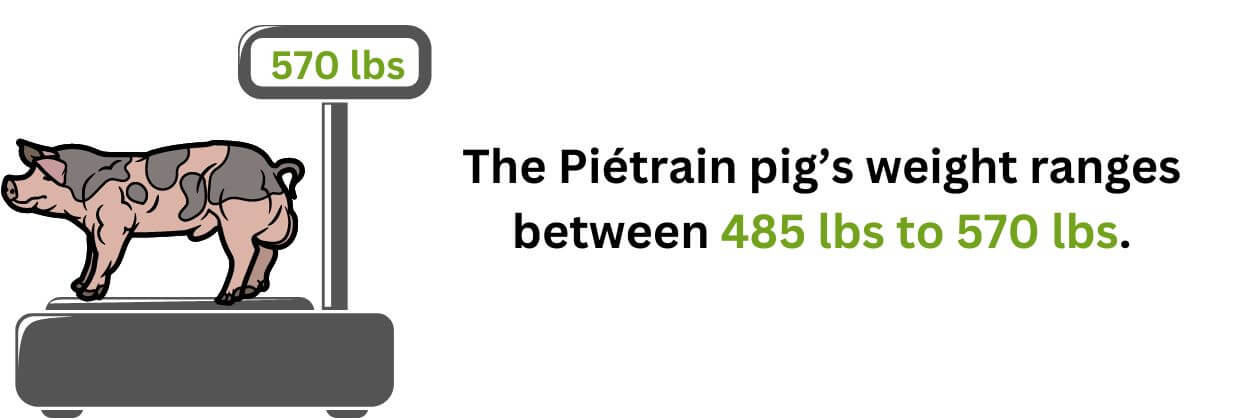
The Piétrain pig’s weight ranges between 485 lbs to 570 lbs. The Piétrain pig boar can weigh between 530 to 570 lbs, while the sow can have a weight of 485 to 520 lbs. As in any other pig breed, the sow has a slightly lower weight than the boar.
Slaughter Time
These pigs are ready for butchering when they reach a weight of 250 to 280 lbs, which happens within 5 to 6 months depending on their diet and other management practices.
Temperament and Behaviour
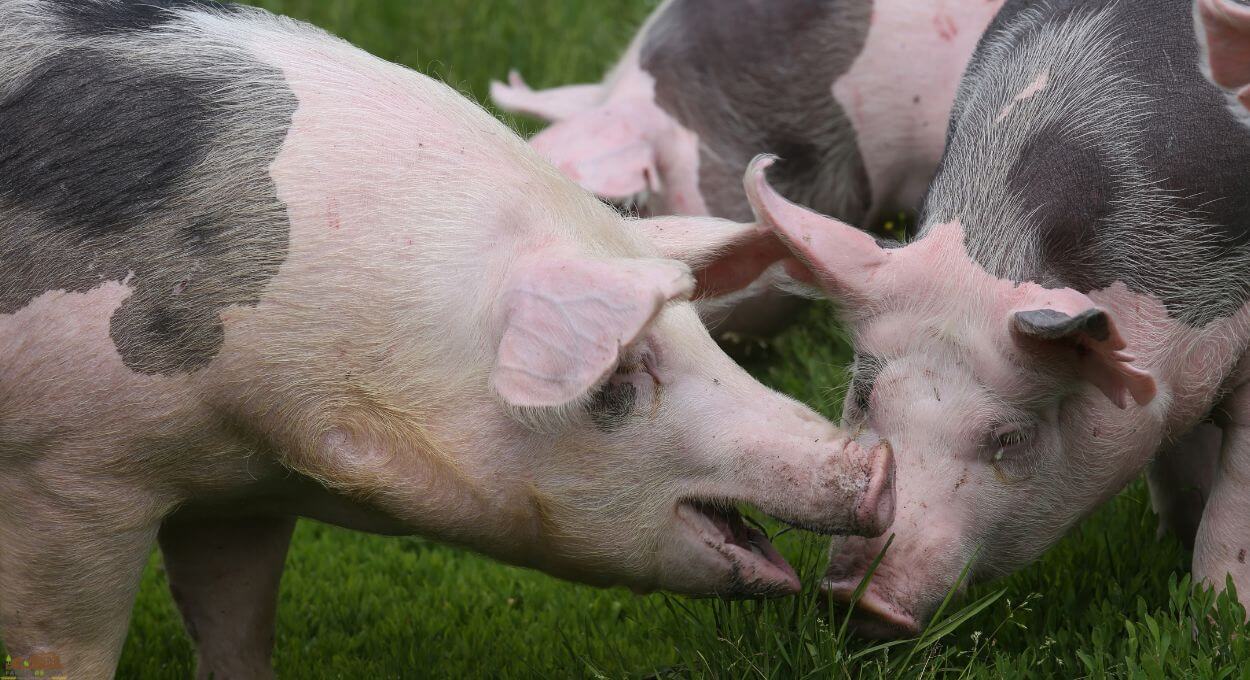
Piétrain pigs are generally considered a docile pig breed, but they can sometimes be more challenging to raise compared to other pig breeds such as Gloucestershire Old Spots pigs.
These pigs are known to have a more nervous temperament, which can occasionally lead to aggressive behavior, especially in situations they evaluate as stressful or dangerous. They may react aggressively toward other animals, pigs, and even humans.
In a stress-free environment, these pigs typically behave calmly and do not pose a threat to humans. But, I recommend you to not leave small children around them without close supervision.
In addition to their nervous temperament, Piétrain pigs are active and energetic. They enjoy satisfying their curiosity by exploring their environment.
An interesting aspect of their behavior is that Piétrain pigs live in groups, which have a specific social hierarchy based on dominance. This social hierarchy results in various interactions between pigs, ranging from gentle to more serious, which can sometimes lead to pigs harming each other.
Meat
Piétrain pig meat quality is highly regarded due to its leanness, tenderness, and flavor.
Here are some facts about the leanness of Piétrain pig meat:
- The meat of these pigs is extremely lean, reaching a percentage of 66.7% of lean meat. When compared to other pig breeds like Mangalica (30-35%), the difference is very big.
- Piétrain pigs have a high yield of defatted loin, cutting out 24.5% of lean meat.
- The hams of Piétrain pigs average at 24.6%.
- The lean-to-fat ratio of Piétrain pigs is 9.2 to 1, whereas breeds like Duroc have a ratio of 5 to 6 to 1.
It’s important to note that Piétrain pig meat is not well-marbled, as the fat content is low, usually with approximately a quarter-inch layer in some cuts. Whether this is considered good or bad depends on individual preferences and the desired outcome for the meat.
The meat is also less juicy and has lower moisture content compared to other meats. This drier texture is also a result of its leanness and lower fat content.
Piétrain pig carcasses are recognized for their high quality, boasting the highest meat content among pigs, with a percentage of 83%.
The meat of these pigs is often used for grilling and roasting as fresh cuts, incorporated into sausages and ham products, and utilized in processed pork items such as meatballs or meatloaf.
Like meat from other pig breeds, the meat of Piétrain pigs is also rich in various nutrients and minerals, including omega-3 and omega-6 fatty acids, iron, zinc, phosphorus, selenium, thiamine, vitamin B6, and vitamin B12.
Saturated and unsaturated fatty acids in the back fat of several modern pig breeds and Piétrain
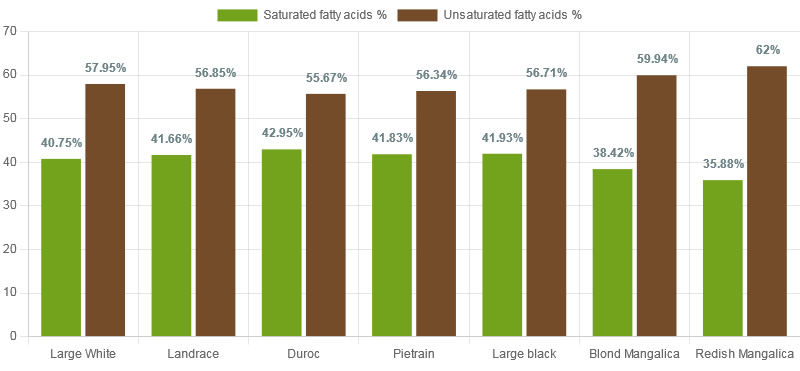
Growing Piétrain Pig
You can raise up to 30 Piétrain pigs per acre.
However, this pig breed is often raised in shelters. So, how much space do you need to raise pigs?
Regardless of the shelter, barn, or pen you use, it is important to ensure that each pig has 8 to 10 square feet of space. While this may seem like a relatively small amount of space, it is sufficient for Piétrain pigs as they are not highly active. Still, they require enough room to move around.
A pen for 10 pigs would ideally have a minimum size of 80-100 square feet.
Feeding
Piétrain pigs are not born as foragers or grazers, although they do have these natural behaviors and instincts. While they have the ability to forage for food in an open environment, this pig breed relies a lot on the feed provided to them.
If they are not raised in an open environment or lack access to pasture, they depend entirely on the feed given to them.
As a breeder, it is crucial to ensure that the pigs receive the necessary calorie intake, as well as vitamin and mineral supplements, on a daily basis.
Why is calorie intake so crucial? It is because Piétrain pigs have a fast metabolism due to their muscular build. If they are not fed enough, they will lose muscle mass and appear deflated.
Their diet should include a mix of protein and easily digestible carbohydrates. This can be achieved through a combination of grains, legumes, vegetables, fruits, boiled eggs and potatoes, roots, meat, fish, and dairy.
Fact: I suggest you not add lots of grains to Piétrain pig’s diet because this makes them lose weight. Why? Their ability to digest grains, such as corn, barley, or oats, is relatively poor.
Additionally, it is important to include a proper ratio of salt in their daily diet. Unlike Idaho pasture pigs, Piétrain pigs actually require salt in their diet. Salt, specifically sodium chloride, is essential for various physiological functions in these pigs.
When raising Piétrain piglets, it is important to provide them with supplemental food from the early days of life, as they cannot rely only on the milk received from the sow.
Environment
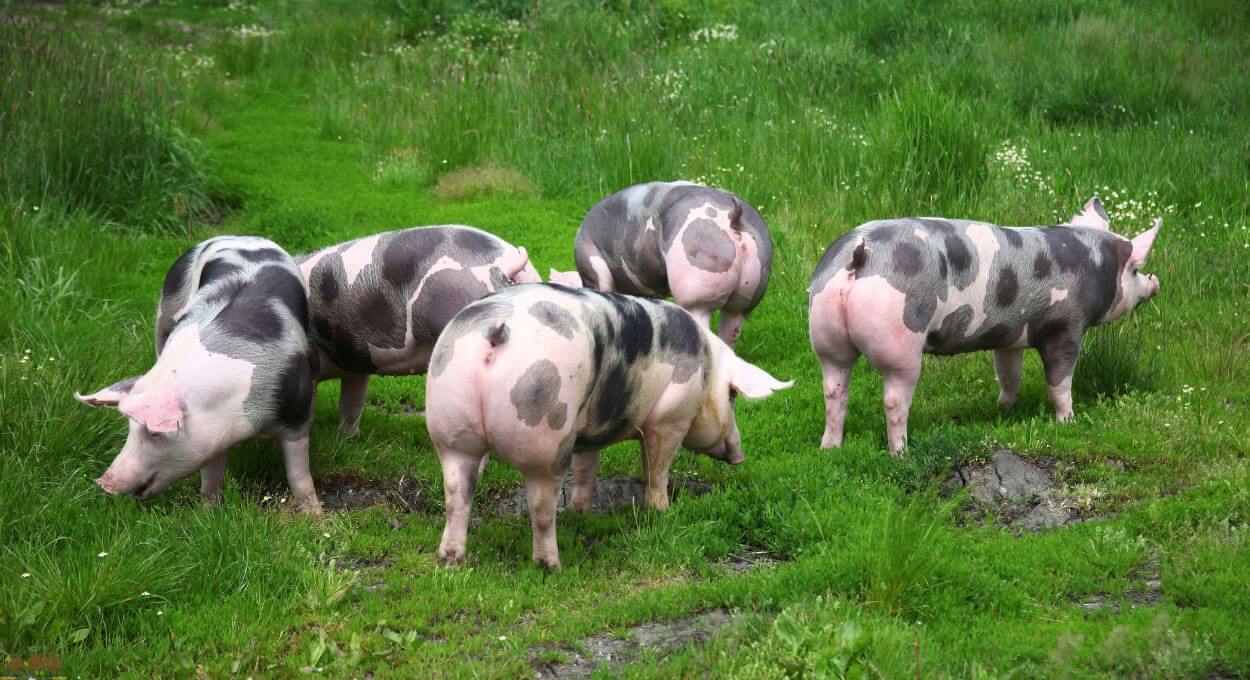
This pig breed can be raised in a variety of environments. Different types of housing systems, such as barns, pens, or shelters, can be used for raising Piétrain pigs. These housing systems should provide ample space for the pigs and be well-ventilated to maintain good air quality.
If not kept indoors, Piétrain pigs can be raised in outdoor environments like pasture-based or free-range systems that are typically enclosed with an electric fence.
Overall, Piétrain pigs adapt well to different types of environments and can thrive in the conditions provided to them.
Climate
The ideal climate for these pigs is the mild European one. They do not do well in cold or hot climates.
The critical cold temperature for Piétrain pigs is around 59°F (15°C). While this may not be considered very cold for some pig breeds, it can be uncomfortable for Piétrain pigs due to their low-fat content. On the other hand, the critical hot temperature for Piétrain pigs is around 86°F(30°C).
It is not impossible to raise these pigs in colder or hotter climates; however, it is crucial to take extreme care and provide them with the appropriate conditions and measures to ensure their survival and well-being.
Shelter
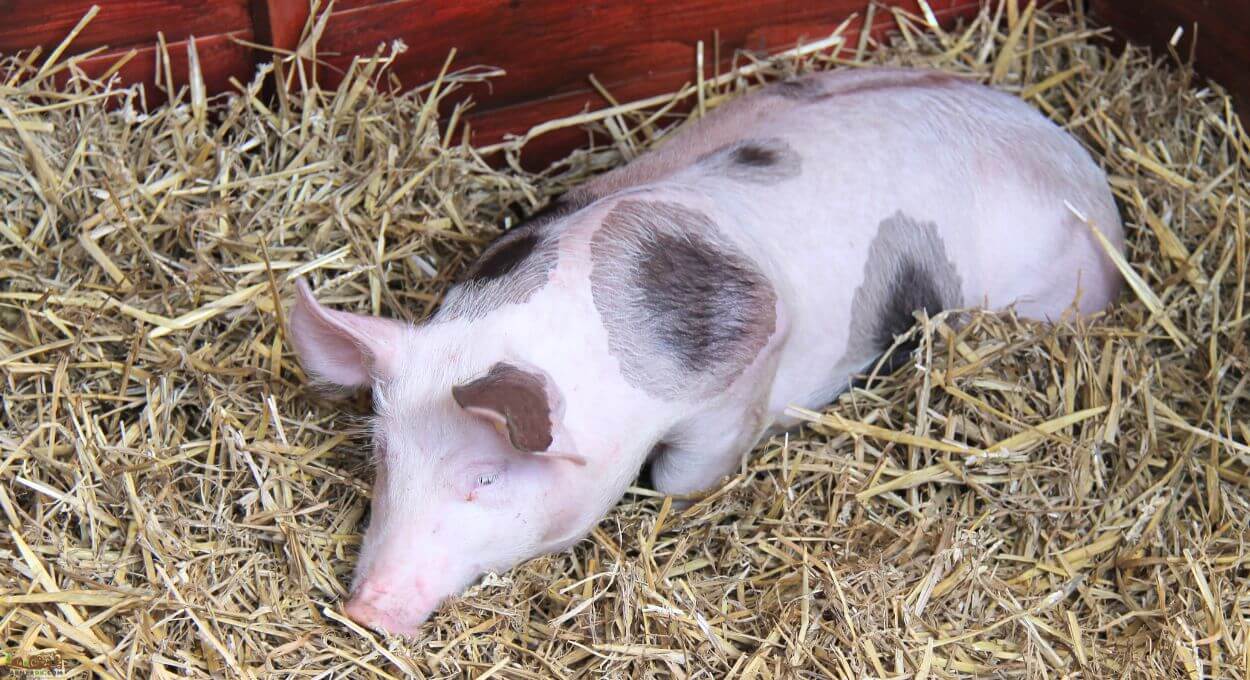
Piétrain pigs require shelter and bedding when raised in an outdoor environment. An appropriate pig shelter provides protection from harsh weather conditions, including intense wind, extreme cold or hot temperatures, and heavy rain.
In addition to shelter, if you live in a hotter climate, you can also consider providing them with a sprinkler system. This system helps cool the pigs down, regulate their body temperature, and reduce heat stress.
Overall, ensuring suitable shelter and implementing additional cooling measures can contribute to the well-being and comfort of Piétrain pigs in various outdoor environments.
Health issues
Piétrain pigs are hardy but can be prone to various health issues such as:
– Heat stress: These pigs are not well-suited for hot and humid climates due to their low-fat content. As a result, they are susceptible to heat stress.
– Muscular disorders: Due to their extreme muscling, Piétrain pigs can experience muscle stiffness and strains.
– Respiratory diseases
– Reproductive issues: Piétrain sows have low milk production and difficulties during farrowing.
– Joint issues: The rapid growth and heavy muscling of Piétrain pigs can put stress on their joints. Providing bedding can help ensure their comfort and support their joints.
Breeding
When breeding Piétrain pigs, it is important to consider several factors.
While these pigs reach sexual maturity fast, typically around 8 months old, it is generally recommended to wait until the Piétrain sow is at least 10 months old before breeding.
This breed is known to have limited mothering skills, and their milk production is often not enough to feed more than 6 Piétrain piglets.
The Piétrain pig litter size is 8 to 10 piglets.
Therefore, supplemental feeding is necessary for litters with 6 or more piglets from their early days after birth.
Fact: To maintain the sow’s low milk production for an extended period, it is recommended to feed the sow 4 to 5 times per day, ensuring a high-calorie intake.
Now, regarding the breeding process itself, it is essential to understand what pig breeds can be used for crossbreeding with Piétrain pigs.
Inbreeding of this breed, meaning breeding of Piétrain sow and boar, is generally not recommended due to the potential risks associated with genetic defects and health issues. The inbreeding should be done only under carefully controlled conditions to ensure the health and desired traits of the offspring.
Piétrain pigs are commonly used for crossbreeding with other pig breeds, with Duroc, Landrace, and Large White being popular choices. This involves using a Piétrain boar and a sow from the other pig breeds.
Fact: Crossbreeding Piétrain with other breeds, particularly in the production of F1 offspring or first-generation crossbreeds, results in significant improvements in certain traits due to the genetic influence of Piétrain.
Fact: Crossbreeding Piétrain with pig breeds that have a higher fat content leads to a reduction in the fat percentage of the offspring, thanks to the exceptional muscling gene present in Piétrain.
One of the common crossbreeds that people prefer is the combination of Piétrain and Duroc.
During my research and I came across a study that explores the quality of the meat produced by pigs resulting from the Piétrain-Duroc cross. According to the study, the meat from this crossbreeding is redder, which is significant as it can influence consumer preferences. Additionally, it has a higher percentage of intramuscular fat, which contributes to its flavor and tenderness, while maintaining the same moisture percentage.
Additional tips for raising Piétrain pigs
- Ensure that their bedding area is always clean to prevent them from getting skin burns from urine.
- Make sure they have a continuous supply of clean and fresh water. These pigs require constant access to water.
- Pay attention to their muscle development and watch for signs of muscular disorders or strains.
- Avoid excessive inbreeding to minimize the risk of genetic defects.
Why should you raise it?
Piétrain is a terminal pig breed, primarily used for crossbreeding purposes to produce new pigs with desirable traits.
Profitability
Raising Piétrain pigs as a small to medium business may not offer you substantial profits, but it can help cover a portion of your overall expenses.
By selling pigs, both boars and sows, you can generate some income, with boars typically priced around $300 and sows around $250. Additionally, selling piglets at prices ranging from $50 to $70 can contribute to your revenue stream. Moreover, the meat itself can be a source of income.
It’s essential to consider the associated expenses involved in raising Piétrain pigs. Building a suitable shelter, ensuring fresh bedding with straw, installing an electric fence, and providing feed are all costs that need to be taken into account. The cost of feed can be significant, considering that Piétrain pigs rely heavily on provided feed rather than grazing. Their fast metabolism and high muscle content result in increased food consumption, which can contribute to higher feed expenses.
Personal Use
As a homesteader, if you want to produce your own lean meat with a very low-fat content, raising Piétrain pigs can be a good choice. This pig breed offers lean cuts of meat for you and your family. With their growth rate, you can consistently have an ample supply of meat available on your homestead.
Advantages and Disadvantages
The Piétrain pig breed has a series of advantages and disadvantages. Table 1 provides a general overview of the pros and cons of the Piétrain pig.
| Advantages | Disadvantages |
|---|---|
| Extreme muscling | Potential reproductive issues |
| Very lean meat | Susceptible to heat stress and joint issues |
| Fast growth rate | No mothering skills |
| Early sexual maturity | Low milk production in sow |
| Suitable for crossbreeding with other breeds (Duroc, Large White, Landrace) | Difficult to inbreed |
| Good litter size | Sensitivity to stress |
| Long lifespan | Aggressive behavior in stressful situations |
| High-quality carcass |
Below is an audio file where you can hear the pronunciation of Piétrain.


thank you for the information
I have also have that kind of pig from Philippines